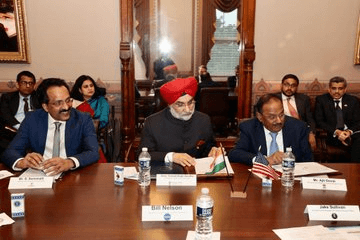According to the White House, the US will provide advanced training for an Indian astronaut, and the two countries will collaborate on planetary defense against dangerous asteroids and comets.
The White House said that one of the initiatives launched at the inaugural meeting of the US-India initiative on Critical and Emerging Technology (iCET) in Washington on Tuesday was to strengthen cooperation in human space flight through an exchange that includes advanced training for an Indian astronaut at NASA’s Johnson Space Center in Houston, Texas.
Ajit Doval of India and Jake Sullivan of the United States led the iCET meeting, which included space, scientific, defense, and commerce officials.
According to the White House, another initiative at the iCET meeting was to include planetary defense on the agenda of the US-India Civil Space Joint Working Group (CSJWG).
The US planetary defense program monitors asteroids and comets to identify those that may cause harm to the Earth, issue warnings, and develop mitigation measures.
Cooperation with the United States on manned space flight would be a departure for India, which has previously relied on the Soviet Union and, after its demise, Russia.
Under an agreement with Russia’s Glavkosmos organization, India has been training four astronauts in Russia in preparation for the launch of the Gaganyaan spacecraft as early as next year.
While astronauts from a variety of countries, including Saudi Arabia,have flown on NASA space missions, none from India have.
Rakesh Sharma, a former Air Force pilot who flew on a Soviet Soyuz mission in 1984, is the only Indian citizen who has been in space.
According to the White House, other initiatives from the iCET meeting include strengthening bilateral commercial space partnerships between the US Commerce Department and the Indian Department of Space.
Earlier, Indian and US space officials met for two days on Monday and Tuesday to discuss several areas of cooperation, including collaboration in human space flights, Earth and space science, global navigation satellite systems, spaceflight safety and situational awareness, and policies for commercial space activities, according to the State Department.
The meeting was co-chaired by Principal Deputy Assistant Secretary of State Jennifer Littlejohn and National Aeronautics and Space Administration (NASA) Associate Administrator Karen Feldstein on the US side and by Shantanu Bhatawdekar, the Indian Space Research Organisation (ISRO) Scientific Secretary on the Indian side.
A highlight of the NASA-ISRO cooperation is the Synthetic Aperture Radar (NISAR) mission, planned for next year.
It is expected to map the Earth systematically, using two different radar frequencies to monitor resources like water, forests, and agriculture.
It will provide data on ecosystems, the Earth’s surface, natural hazards, sea level rise, and the cryosphere, or frozen parts of the Earth, with applications in forestry, agriculture, and ecology.
According to NASA, it will also aid in the rapid response to natural and man-made disasters.
The meeting was opened by NASA Administrator Bill Nelson and National Space Council Executive Secretary Chirag Parikh, and ISRO Chairman S Somanath and Taranjit Singh Sandhu spoke.
While there have been no Indian citizens on US space missions, four Indian-Americans have.
Kalpana Chawla, who died in the Space Shuttle Columbia disaster in 2003, Sunita Williams, and Raja Chari were among those who flew on NASA missions.
In 2021, Sirisha Bandla flew on a private-sector Virgin Galactic test flight.
Source:OCN







 Finance
Finance







